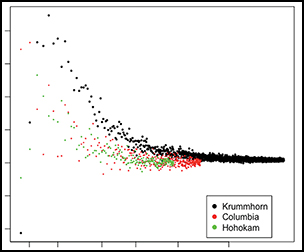Crossref Citations
This article has been cited by the following publications. This list is generated based on data provided by
Crossref.
Ames, Kenneth M.
and
Grier, Colin
2020.
Inequality on the Pacific Northwest Coast of North America measured by house-floor area and storage capacity.
Antiquity,
Vol. 94,
Issue. 376,
p.
1042.
Prats, Georgina
Antolín, Ferran
Alonso, Natàlia
and
Biehl, Peter F.
2020.
Household storage, surplus and supra-household storage in prehistoric and protohistoric societies of the Western Mediterranean.
PLOS ONE,
Vol. 15,
Issue. 9,
p.
e0238237.
Basri, Pertev
and
Lawrence, Dan
2020.
Wealth Inequality in the Ancient Near East: A Preliminary Assessment Using Gini Coefficients and Household Size.
Cambridge Archaeological Journal,
Vol. 30,
Issue. 4,
p.
689.
Bowles, Samuel
and
Carlin, Wendy
2020.
Inequality as experienced difference: A reformulation of the Gini coefficient.
Economics Letters,
Vol. 186,
Issue. ,
p.
108789.
Fochesato, Mattia
Higham, Charles
Bogaard, Amy
and
Castillo, Cristina Cobo
2021.
Changing social inequality from first farmers to early states in Southeast Asia.
Proceedings of the National Academy of Sciences,
Vol. 118,
Issue. 47,
Wroński, Marcin
2021.
Long-term evolution of income inequality in the large Polish city. The income distribution in Warsaw in 1833, 1925, and 2017..
SSRN Electronic Journal ,
Parcero-Oubiña, César
and
Nión-Álvarez, Samuel
2021.
Forms of settlement inequality over space. A GIS-based method for measuring differences among settlements.
Journal of Archaeological Science: Reports,
Vol. 35,
Issue. ,
p.
102739.
Thompson, Amy E.
Feinman, Gary M.
Prufer, Keith M.
and
Freeman, Jacob
2021.
Assessing Classic Maya multi-scalar household inequality in southern Belize.
PLOS ONE,
Vol. 16,
Issue. 3,
p.
e0248169.
Green, Adam S.
2021.
Killing the Priest-King: Addressing Egalitarianism in the Indus Civilization.
Journal of Archaeological Research,
Vol. 29,
Issue. 2,
p.
153.
Alfani, Guido
2021.
Economic Inequality in Preindustrial Times: Europe and Beyond.
Journal of Economic Literature,
Vol. 59,
Issue. 1,
p.
3.
Morris, Ian
2022.
Against Method.
American Journal of Archaeology,
Vol. 126,
Issue. 3,
p.
E65.
Scheidel, Walter
2022.
Capital in Classical Antiquity.
p.
355.
van Bavel, Bas
2022.
Wealth inequality in pre‐industrial Europe: What role did associational organizations have?.
The Economic History Review,
Vol. 75,
Issue. 3,
p.
643.
Klinkenberg, Victor
2022.
Building biographies of the Cypriot Chalcolithic.
Levant,
Vol. 54,
Issue. 3,
p.
295.
Nørtoft, Mikkel
2022.
A New Framework for Quantifying Prehistoric Grave Wealth.
Journal of Computer Applications in Archaeology,
Vol. 5,
Issue. 1,
p.
123.
Sargentis, G.-Fivos
Koutsoyiannis, Demetris
Angelakis, Andreas
Christy, John
and
Tsonis, Anastasios A.
2022.
Environmental Determinism vs. Social Dynamics: Prehistorical and Historical Examples.
World,
Vol. 3,
Issue. 2,
p.
357.
Linares-Matás, Gonzalo J.
2022.
Spatial Organization and Socio-Economic Differentiation at the Dhar Tichitt Center of Dakhlet el Atrouss I (Southeastern Mauritania).
African Archaeological Review,
Vol. 39,
Issue. 2,
p.
167.
Munson, Jessica
and
Scholnick, Jonathan
2022.
Wealth and Well-being in an Ancient Maya Community.
Journal of Archaeological Method and Theory,
Vol. 29,
Issue. 1,
p.
1.
Sargentis, G.-Fivos
and
Koutsoyiannis, Demetris
2023.
The Function of Money in Water–Energy–Food and Land Nexus.
Land,
Vol. 12,
Issue. 3,
p.
669.
Greenwald, Alexandra M.
Burns, Gregory R.
Eerkens, Jelmer W.
Bartelink, Eric J.
Leventhal, Alan
and
Arellano, Monica V.
2023.
Sex‐biased parental investment and female wealth accumulation in ancientCalifornia.
American Journal of Biological Anthropology,
Vol. 182,
Issue. 1,
p.
109.



